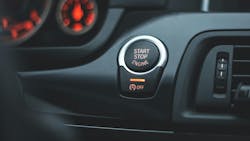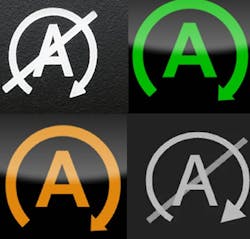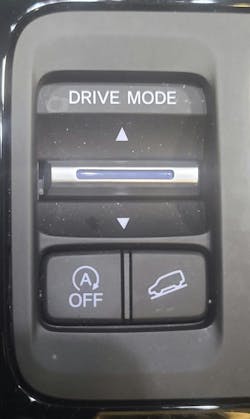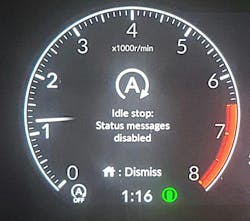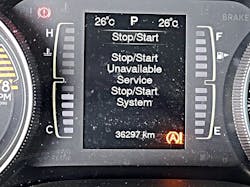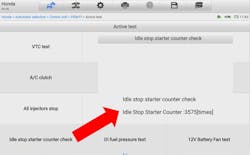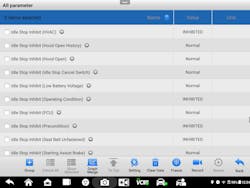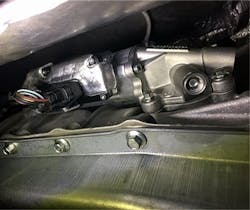Key Highlights for Technicians
- Start-Stop systems aim to reduce emissions and improve fuel economy by managing engine shutdowns at stops, relying on multiple sensors and modules for decision-making.
- Proper battery type (EFB, AGM) and registration are critical; misdiagnosis often stems from overlooked battery health or incorrect setup procedures.
- System inhibitions are common and can be caused by hood switches, seat sensors, HVAC conditions, or communication errors, often without setting DTCs.
- Upgraded starters, alternators, and transmission components are essential for durability in frequent start-stop cycles, with specific design features to handle increased stress.
- Effective diagnosis requires understanding OEM-specific logic, checking communication networks, and considering recent software updates that may alter system behavior.
The Start-Stop system isn’t new anymore, but it continues to confuse both drivers and technicians alike. A customer complaint of "my car doesn’t shut off at stoplights anymore" is something many shops see frequently. With so many OEM-specific systems, inputs, and activation conditions, it’s no wonder these systems cause diagnostic headaches. But with a solid understanding of how Start-Stop works and more importantly, why it might not be working, we can narrow down the root cause faster.
Start-Stop systems are designed to reduce idle emissions and improve fuel economy by shutting down the engine when the vehicle is stopped and restarting it when the brake is released. They have been installed in nearly every new platform since 2015. That’s the easy part. Behind the scenes, the system is using data from multiple sensors and modules to decide if it’s safe to shut down the engine. Battery voltage and temperature, brake vacuum, cabin HVAC demand, gear choice, and even the position of the hood switch all play a role.
Idle Stop, ESS and Auto Stop are simply different names for the same system. It’s worth noting that not all automakers use the same name for these systems. Honda calls it Idle Stop, Jeep uses ESS (Engine Stop Start), Mazda has i-Stop. While the function is similar across brands, the activation logic and naming can confuse both techs and drivers, especially if they’ve just switched vehicles.
Start-Stop System Differences
The Battery Start-Stop vehicles place extra demands on the battery, especially with how often the engine shuts off and restarts in traffic. Standard flooded batteries just aren't built for that kind of cycling. That’s where EFB (Enhanced Flooded Batteries) come in.
EFBs are basically beefed-up versions of standard lead-acid batteries. They’re built to manage the added stress of Start-Stop operation. You’ll usually see EFBs in base model Start-Stop vehicles that don’t have a lot of extra electronics but still need to crank the engine more often than normal.
AGM (Absorbent Glass Mat) batteries are the next level up. These are designed for vehicles with heavier electrical loads or systems like regenerative braking. They recover charge faster, tolerate deeper discharges, and hold up better under heat and vibration. Since they’re sealed, there’s no worry about leaks, which is why they can be mounted in less traditional locations like under the rear seat or in the trunk.
Other vehicles go even further by using two batteries: one to start the engine and another to handle accessories when the engine’s off. This setup keeps everything running without putting too much strain on a single battery. Dual batteries aren’t the only power source that have been used to prevent flickering screens, dropped Bluetooth connections, or glitches in the HVAC controls. Capacitors have been used but most manufacturers are using DC-to-DC convertors to keep key electrical systems alive when the engine shuts off at a light.
The DC-DC converter takes power from the 12V main battery and regulates it down to support sensitive electronics like the instrument panel, radio, and control modules. And when the engine restarts, it helps smooth out the transition so there’s no voltage spikes or drops that could interrupt systems. The in-rush starter current can easily reach 800 amps, and voltage can drop to 11.5V while restarting a V8, and these current and voltage fluctuations need to be smoothed out.
Some GM models equipped with Start-Stop can set a P3055 (DC/DC Converter Output Voltage 1 Performance) in the PCM. This DTC could be a misconfiguration issue, requiring reflashing and setup procedures, or it could be the Power Supply Transformer has failed.
On the 2018 Honda Odyssey Elite with Start-Stop, a dedicated 12-volt battery cooling fan is used to help manage battery temperature. The PCM controls the fan based on data from the 12-volt battery sensor mounted on the negative battery terminal. This sensor watches battery voltage, charge and discharge current, and fluid temperature. If the battery gets too warm, especially at low vehicle speeds, the fan kicks on to protect it from heat-related damage. If the fan fails or communication is lost between the PCM and battery sensor, the system can trigger DTC P16E7. There’s also a failsafe that forces the fan on if intake air temperature hits 95 degrees Fahrenheit or higher, even if battery sensor data is missing.
Starter and Alternator Differences
On a regular vehicle without Start-Stop, the starter motor might get used about 50,000 times over its lifetime, basically just from starting the engine once or twice a day. But in a vehicle with Start-Stop, that number can climb to well over 500,000 starts, especially in city driving or stop-and-go traffic. A regular starter wouldn’t last long in a Start-Stop setup, since it just isn’t built for that kind of constant use. That’s why these systems use a much tougher starter. They’re built for the job, with beefed-up internal parts like heavier brushes, reinforced bearings, better windings, and in many cases, a gear-reduction drive to handle the extra torque and frequent cycles.
The engagement mechanism is faster and quieter too, which helps smooth out the restart when the engine kicks back on. The housing, solenoid, and even the cooling design are often upgraded to deal with the extra heat and vibration from all that added use. Basically, it’s not just a better starter, it’s a completely different class of component.
A common Toyota starter motor related DTC that we see in the service bay is the DTC P1542:00, which shows up when the engine doesn’t restart fast enough during a Start-Stop event. Specifically, it sets when engine speed stays below 400 rpm for more than 1.38 seconds during a restart.
The usual suspect here is a weak or failing battery, but it’s not always that simple. Low fuel pressure, injector faults, or even a dirty throttle body can also delay the restart just enough to trigger this code. The system expects the engine to fire up fast and smoothly. If it doesn’t, even for a second and a half, it’ll let you know.
In a Start-Stop vehicle, the alternator must do more than just keep the battery charged. It needs to recover energy quickly and handle frequent charging cycles without burning out. When the engine restarts, it’s expected to bring the battery voltage back up quickly and support things like power steering, HVAC, and infotainment, which all keep running while the engine’s off. Most Start-Stop systems use an upgraded high-output alternator combined with a smart charging system that can ramp up output fast after every restart. Some systems also use what's called a brake energy regeneration alternator, which increases charging during deceleration.
HVAC and Cooling Considerations
A common complaint with Start-Stop systems is the drop in cabin comfort when the engine shuts off, especially on hot or cold days. Since most of these systems use belt-driven A/C compressors (today’s hybrids typically use an electric compressor), there’s no compressor operation when the engine isn’t running. To work around this, manufacturers have made HVAC system upgrades specifically for Start-Stop vehicles. A common solution is the use of a cold-storage evaporator that uses a phase change material (PCM), or similar heat-absorbing material built into the evaporator core to store cooling capacity while the engine is running. This cold storage helps maintain air temperature during short engine-off periods. Some systems also adjust blower speed or delay the Start-Stop event entirely if interior temps start to rise too quickly.
On the heating side, it’s the opposite problem. If the engine shuts off, so does coolant flow, and that can leave the cabin without warm air in colder weather. To avoid this, many Start-Stop vehicles use electric coolant pumps to keep warm coolant circulating through the heater core while the engine is off. This helps maintain cabin heat during idle-stop events and avoids triggering an auto-restart just to restore heat. Failed electric coolant pumps are common as vehicles age. The Ford “Coolant Pump A” is part of the high-temp loop in Start-Stop, hybrid, and plug-in hybrid systems. It keeps hot coolant flowing to the heater core when the engine shuts off, and if it fails, you'll see DTCs like P2600–P2603 for circuit or performance faults.
The HVAC system is also tied into the Start-Stop control logic. If the cabin is too hot or too cold, or if the defrost is active, the PCM may block engine shutdown completely. This is why you’ll sometimes notice the engine stays running in traffic, even though the Stop-Start system is enabled. The vehicle is putting occupant comfort first.
Engine and Transmission Designs
Engines in Start-Stop vehicles need internal upgrades to handle the constant restarting. Low-friction coatings on pistons and polymer or tri-metal layers on crankshaft and other engine bearings protect against dry-start wear. The starter ring gear and flywheel are also reinforced to handle the higher number of engagements.
The transmission needed modification as well. One key change is the use of a low-leak valve body. In most automatics, transmission fluid pressure drops quickly once the engine shuts off, which can lead to a slight delay or harsh engagement when the engine starts again. In a Start-Stop vehicle, the valve body is redesigned to hold clutch pressure longer during engine-off periods so the transmission can re-engage smoothly and instantly.
Another change is the addition of an auxiliary electric transmission fluid pump or a Start-Stop accumulator. These devices maintain transmission line pressure and keep the torque converter filled when the engine is off.
Start-Stop Diagnostics: Don’t Skip the Basics
One of the most common complaints with Start-Stop systems is “it’s not working.” But in most cases, that’s not because something’s broken, it’s because something is intentionally preventing it from working. These systems are picky, and there are a lot of conditions that can shut them down quietly in the background.
Start by checking the battery or batteries. It’s surprising how often this gets missed. Start-Stop systems aren’t designed for your typical flooded battery. They need AGM or EFB types that can handle repeated deep cycling. And it’s not just about having the right battery; it also needs to be registered to the vehicle. Skip that step and you’ll get incorrect state-of-charge readings, which lead to false system disables.
A common DTC on Jeep vehicles is P057F: 14 Volt Battery State of Charge Performance. This code can be set when the PCM receives a message from the Intelligent Battery Sensor on the CAN C bus that the battery state of charge is outside the calibrated range. The most common resolution is the replacement of the battery with the correct size and model and then clearing the code.
We had a 2019 F-150 5.0L in the shop recently. The customer had just had the battery replaced elsewhere, but the Start-Stop still wouldn’t activate. Turns out the Battery Management System (BMS) reset was never done. Once we completed the reset using a scan tool, everything worked fine again. If your scan tool won’t reset the Ford BMS, you can reset it manually. To reset the BMS, turn the key to the "on" position without starting the engine (or press the start button without your foot on the brake). Flash the high beams five times, then press the brake pedal three times. If the battery light starts flashing, the reset is working. Once it stops, cycle the ignition off and back on to confirm.
Ford systems are sensitive to that BMS logic: if the reset doesn’t happen, it could overcharge or undercharge the battery or disable the Start-Stop to protect it.
The Jeep Cherokee is another good one to watch. We’ve seen several come in with complaints about the ESS system not functioning. In most cases, the problem is traced back to a faulty hood latch switch. It doesn’t set a DTC, but it tells the system the hood is open which is enough to suppress the Start-Stop system every time. A quick check with a scan tool or jumper at the switch connector saves a lot of wasted diagnostic time.
Here’s another common Start-Stop issue: after battery replacement or certain repairs, the system needs time to relearn the battery State of Charge (SOC) and re-establish voltage references. GM requires at least a 75% SOC for the system to operate correctly. For a vehicle to relearn the battery SOC, it can take up to three or four consecutive hours of key-off time, with the vehicle undisturbed and drawing less than 100mA (Sleep Mode). If the customer or tech opens the door or hood during this period, the timer resets and the process is restarted. It’s important to share this information with the customer after a battery replacement to prevent return visits and concerns.
Battery Testing: Get It Right
When testing batteries, don’t rely on an old-school battery tester. EFB and AGM batteries behave differently, especially under partial charge or load. If your tester doesn’t support testing these types of batteries, it might falsely pass a failing battery. This is a very common issue.
Start-Stop Inhibitors and System Logic
Another layer to understanding Start-Stop systems is knowing why they’re being blocked from operating because more often than not, that’s exactly what’s happening. These systems monitor a long list of input conditions, and if even one of them falls outside the accepted range, Start-Stop is inhibited. What makes it tricky is that most of these won’t set a DTC. The system is doing exactly what it’s supposed to, but the driver sees it as a failure.
You might be chasing your tail if you’re not looking at the right data. Inputs like hood switch status, driver seatbelt, brake pedal sensors, door position, brake vacuum, cabin temperature, battery temperature, recent gear selection, and HVAC mode are all part of the equation. Even steering angle, fuel level, or open circuit draw can be used to block Start-Stop, depending on the OEM. And these aren’t always handled by the PCM. In many cases, the Start-Stop logic may live in another module, like the BCM, the instrument cluster, or the HVAC module. This is why a full module scan is needed to address many of todays issues, not just Start-Stop.
Most good tools will give you a breakdown of Start-Stop enable criteria, showing which conditions are currently met and which are not. It’s one of the most useful pieces of data when diagnosing these systems. If Start-Stop won’t engage and you see that “hood switch not closed” or “defrost active” is flagged, that’s your reason right there. We’ve seen plenty of vehicles come in with no codes, no warning lights, just a simple logic block that gets overlooked.
One More Thing to Consider
These systems rely heavily on clean communication between all the major modules. The PCM may oversee the engine restart, but it needs valid inputs from the BCM, TCM, HVAC, and other control modules. If there’s a communication glitch on the CAN network, say a momentary dropout between the cluster and the BCM, the system might quietly disable Start-Stop with no visible warning, but also set a U-code DTC. On platforms with more complex electrical architectures, like those with DC-DC converters or dual batteries, even a low-level communication error can shut things down.
Also, watch for non-OEM accessories or updates. Infotainment upgrades, remote starters, and even older dash cams that cause parasitic draw can interfere with Start-Stop readiness or prevent proper battery status relearn.
Software and Strategy Updates
One more thing to keep in mind: Start-Stop behavior can change after a software update. Several OEMs have issued TSBs to revise Start-Stop logic, sometimes to address nuisance restarts or improve comfort. If a system suddenly starts acting differently after a dealer visit, double-check for recent reflashes. It’s also worth verifying whether the customer has updated modules that affect sleep cycles, especially in newer connected vehicles, that are getting OTA (Over the Air) updates.
Talk to the Customer
Finally, a quick word on communication. A lot of drivers hate Start-Stop. Some disable it manually every time they start the vehicle. And for them, relief may be coming, because while working on this article, news surfaced that the EPA may no longer require Start-Stop systems on future vehicles. But for other drivers who don’t mind the system, they may feel it isn’t working when it’s just inhibited. Take a minute to explain the system and what conditions might prevent it from working. That one-minute conversation can save you a comeback and a lot of confusion. Start-Stop complaints are often the result of misunderstood conditions not mechanical failure. By understanding how the system is supposed to work and what will inhibit it, you can approach diagnostics more confidently. Always verify battery health and registration. Don’t overlook basic inputs like hood switches, brake sensors, or parasitic draw. And when in doubt, take a few minutes to study the OEM criteria for Start-Stop activation. That’s where the answers usually live.
About the Author

Jeff Taylor
Jeff Taylor is a seasoned professional at CARS Inc. in Oshawa with 40 years in the automotive industry. As a skilled technical writer and training developer, he holds licenses in both automotive and heavy-duty vehicle repair. Jeff excels in TAC support, technical training, troubleshooting, and shaping the future of automotive expertise.
